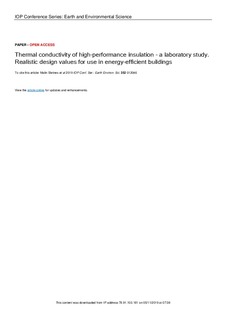| dc.contributor.author | Sletnes, Malin | |
| dc.contributor.author | Elvebakk, Kristin | |
| dc.contributor.author | Gaarder, Jørn Emil | |
| dc.contributor.author | Rognvik, Egil | |
| dc.contributor.author | Grynning, Steinar | |
| dc.date.accessioned | 2019-11-06T06:06:06Z | |
| dc.date.available | 2019-11-06T06:06:06Z | |
| dc.date.created | 2019-11-05T08:43:21Z | |
| dc.date.issued | 2019 | |
| dc.identifier.issn | 1755-1307 | |
| dc.identifier.uri | http://hdl.handle.net/11250/2626753 | |
| dc.description.abstract | Aerogel insulation blankets could be the solution to some of the challenges encountered when designing (energy efficient) buildings. However, uncertainties regarding performance in different applications and environments may limit their use in cases where they could otherwise be employed to advantage. The purpose of this study was to examine how to best adapt European standards for the measurement of thermal insulation properties to aerogel insulation and highlight important aspects to be aware of when evaluating material parameters. We have systematically varied measurement parameters for thermal conductivity and compressive strength to map the impacts on reported material properties. Furthermore, we have compared the measurement conditions to actual conditions in selected building applications. In conclusion we propose that the European (EN) standard for measuring compression behavior for insulation materials should be revised and clarified with regards to materials that do not exhibit a clear elastic domain. We also suggest that the thermal conductivity of aerogel insulation blankets should be measured with a slight compressive load on the material, but that the calculation of the thermal conductivity should nevertheless be based on the measured sample thickness. | nb_NO |
| dc.language.iso | eng | nb_NO |
| dc.publisher | IOP Publishing Ltd. | nb_NO |
| dc.relation.ispartof | 1st Nordic conference on Zero Emission and Plus Energy Buildings | |
| dc.rights | CC BY 3.0 | * |
| dc.rights.uri | https://creativecommons.org/licenses/by/3.0/ | * |
| dc.title | Thermal conductivity of high-performance insulation - a laboratory study. Realistic design values for use in energy-efficient buildings. | nb_NO |
| dc.type | Journal article | nb_NO |
| dc.type | Peer reviewed | nb_NO |
| dc.type | Conference object | |
| dc.description.version | publishedVersion | nb_NO |
| dc.rights.holder | © The authors | nb_NO |
| dc.subject.nsi | VDP::Teknologi: 500 | nb_NO |
| dc.source.volume | 352 | nb_NO |
| dc.source.journal | IOP Conference Series: Earth and Environmental Science (EES) | nb_NO |
| dc.identifier.doi | 10.1088/1755-1315/352/1/012046 | |
| dc.identifier.cristin | 1744021 | |
| dc.relation.project | Norges forskningsråd: 282389 | nb_NO |
| cristin.unitcode | 7401,30,40,0 | |
| cristin.unitname | Arkitektur, byggematerialer og konstruksjoner | |
| cristin.ispublished | true | |
| cristin.fulltext | original | |
| cristin.qualitycode | 1 | |

